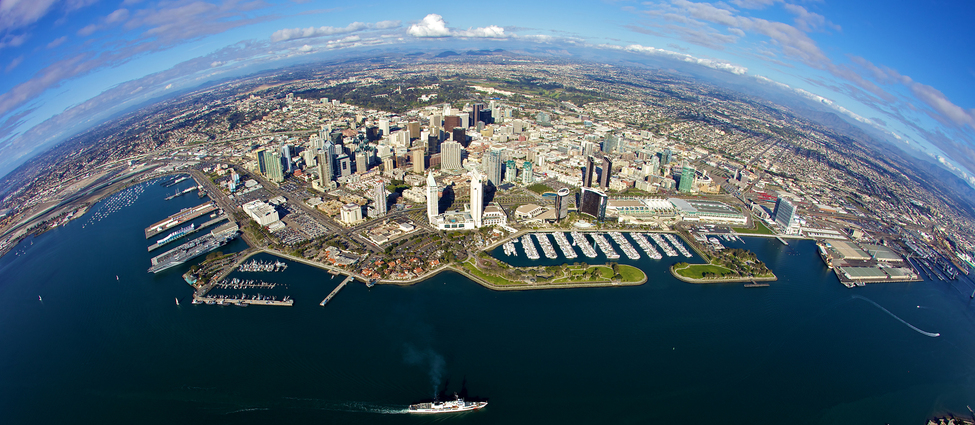

News
Port Advances Wetland Mitigation Bank Project

The Port of San Diego’s proposed wetland mitigation bank project in the South Bay marks a major milestone with two approvals needed to advance the project to the California Coastal Commission for consideration. The project, the first of its kind for San Diego Bay, would create a 76.5-acre coastal wetland mitigation bank on the southern portion of a Port-owned parcel known as Pond 20, a former salt evaporation pond that is currently vacant, isolated from tidal influence, and provides little habitat value due to its salt-encrusted surface and invasive plants.
At its meeting on April 13, 2021, the Board of Port Commissioners certified the Environmental Impact Report for the proposed wetland mitigation bank as well as approved a Port Master Plan Amendment (PMPA) that would add the parcel and use of it as a wetland mitigation bank into the Port’s coastal permitting jurisdiction. The PMPA goes next to the California Coastal Commission. If certified, and state and federal permits are obtained, construction could begin as soon as spring 2022, with completion in late 2023.
For the environment, the wetland would increase biodiversity, supporting a rich variety of wildlife including fish, birds, invertebrates, amphibians, and native plants; provide protection from storm surge, sea level rise and resulting erosion; improve water quality; increase carbon sequestration capacity; and more. As a community benefit, the future wetland and the wildlife it will attract will be easily visible to the thousands of residents and visitors who use the Bayshore Bikeway each week. As both a community and regional economic benefit, it will offer access to wetland mitigation credits for entities, primarily in the San Diego region, needing to meet future mitigation requirements for their developments. Revenue generated from those credits will go toward future public improvement projects and maintenance around the bayfront, with some specifically directed to projects in the adjacent Imperial Beach and San Diego Communities.
“Reclaiming the non-functioning Pond 20 site as a vibrant wetland mitigation bank is a marriage of good environmental policy and economic policy with community and Port benefits as well. It’s a win-win-win-win,” said Dan Malcolm, Imperial Beach’s representative on the Port of San Diego Board of Port Commissioners. “It also provides a road map for a new way to mitigate for coastal development impacts baywide and in our region. Pond 20 is the blueprint of a new way to get it done. This is very exciting.”
In addition to local environmental efforts, the proposed Pond 20 wetland mitigation bank will further complement various existing and proposed federal, state, and regional environmental conservation and climate initiatives including:
- Governor Newsom’s “30 by 30” executive order by which 30 percent of lands and coastal waters in California will be protected by 2030; and
- President Biden’s “30 by 30 conservation goal” by which 30 percent of U.S. lands and ocean territories will be protected by 2030; and
- State Senate Bill 1, the California Sea Level Rise Mitigation and Adaptation Act of 2021 (proposed bill); and
- County Board of Supervisor’s Regional Climate Sustainability Plan.
Pond 20 is located along Highway 75/Palm Avenue in the southernmost portion of San Diego Bay, just south of the San Diego National Wildlife Refuge, east of 13th Street in Imperial Beach, and southwest of the Otay Valley Regional Park. It’s also adjacent to the Otay River Estuary Restoration Project being planned in partnership with the U.S. Fish & Wildlife Service San Diego National Wildlife Refuge Complex and Poseidon Resources LP. The two projects together will restore approximately 200 acres of coastal wetland habitats.
To learn more about the proposed wetland mitigation bank at Pond 20, visit the project page on the Port of San Diego’s website.
About Pond 20
Around 1870, the salt evaporation and extraction industry began operations in south San Diego Bay. The Western Salt Company acquired Pond 20 in the 1890s and created a large complex of networked condensation and crystallization salt evaporation ponds. While the South Bay Salt Works still operates in south San Diego Bay, Pond 20 has not been utilized as an evaporation pond since the 1960s.
The Port purchased the property in 1998 as part of a larger, 1,400-acre land acquisition. Most of the land was transferred to State Lands leading to the creation of the South San Diego Bay National Wildlife Refuge as part of mitigation requirements for the San Diego International Airport Terminal 2 expansion. After the San Diego County Regional Airport Authority became a separate agency from the Port in 2003, the Port retained ownership rights to the project site, as provided in the SB 1896 (2002), with the intent of utilizing the project site for future development, subject to consistency with the Public Trust Doctrine.
ABOUT THE PORT OF SAN DIEGO
The Port of San Diego serves the people of California as a specially created district, balancing multiple uses on 34 miles along San Diego Bay spanning five cities. Collecting no tax dollars, the Port manages a diverse portfolio to generate revenues that support vital public services and amenities.
The Port champions Maritime, Waterfront Development, Public Safety, Experiences and Environment, all focused on enriching the relationship people and businesses have with our dynamic waterfront. From cargo and cruise terminals to hotels and restaurants, from marinas to museums, from 22 public parks to countless events, the Port contributes to the region’s prosperity and remarkable way of life on a daily basis.
ABOUT PORT OF SAN DIEGO ENVIRONMENT Port of San Diego Environment champions the safekeeping and environmental care of our diverse ecosystems. Year after year, environmental goals are set and measured to evolve environmental initiatives – ensuring San Diego Bay remains a vibrant resource and contributes to a remarkable way of life for visitors and residents for generations to come.